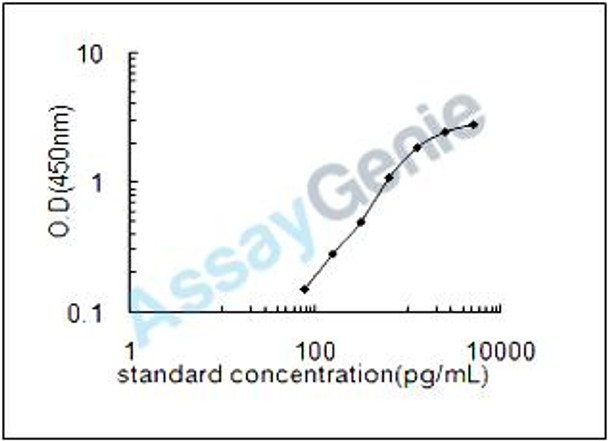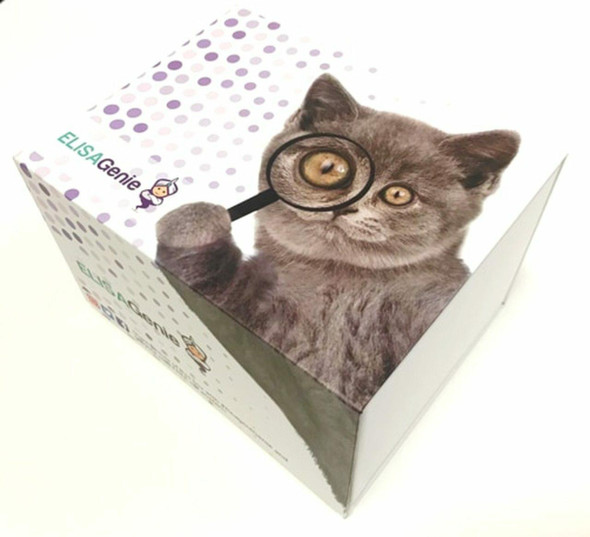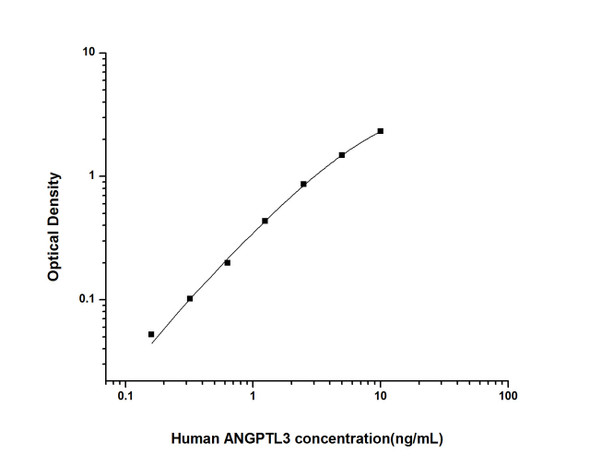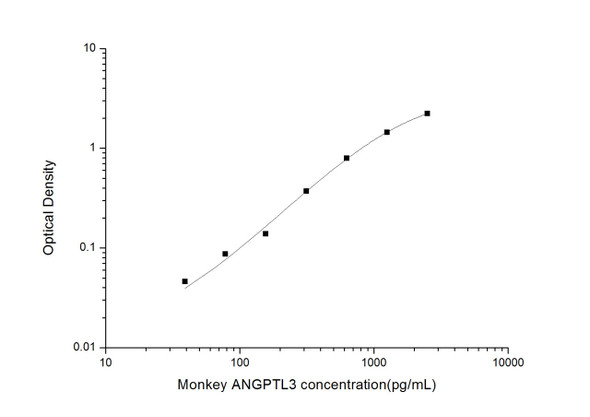Mouse Angiopoietin-related protein 3 (Angptl3) ELISA Kit (MOEB1618)
- SKU:
- MOEB1618
- Product Type:
- ELISA Kit
- Size:
- 96 Assays
- Uniprot:
- Q9R182
- ELISA Type:
- Sandwich
- Reactivity:
- Mouse
Description
Mouse Angiopoietin-related protein 3 (Angptl3) ELISA Kit
The Mouse ANGPTL3 (Angiopoietin-related protein 3) ELISA Kit is a cutting-edge tool for the precise measurement of ANGPTL3 levels in mouse serum, plasma, and cell culture supernatants. This advanced kit offers exceptional sensitivity and specificity, guaranteeing accurate and consistent results for a diverse range of research applications.ANGPTL3 is a key protein involved in lipid metabolism and cardiovascular health, playing a vital role in regulating triglyceride levels and influencing cardiovascular disease risk.
Understanding and monitoring ANGPTL3 levels can provide valuable insights into metabolic disorders, cardiovascular conditions, and potential therapeutic interventions.With its reliability and effectiveness, the Mouse ANGPTL3 ELISA Kit is an indispensable asset for researchers studying lipid metabolism, cardiovascular diseases, and related fields, facilitating in-depth investigations and advancements in scientific knowledge.
| Product Name: | Mouse Angiopoietin-related protein 3 (Angptl3) ELISA Kit |
| SKU: | MOEB1618 |
| Size: | 96T |
| Target: | Mouse Angiopoietin-related protein 3 (Angptl3) |
| Synonyms: | Angiopoietin-like protein 3 |
| Assay Type: | Sandwich |
| Detection Method: | ELISA |
| Reactivity: | Mouse |
| Detection Range: | 78-5000pg/mL |
| Sensitivity: | 39.1pg/mL |
| Intra CV: | 5.6% | ||||||||||||||||||||
| Inter CV: | 8.3% | ||||||||||||||||||||
| Linearity: |
| ||||||||||||||||||||
| Recovery: |
| ||||||||||||||||||||
| Function: | Involved in angiogenesis (PubMed:11877390). Binds to endothelial cells via integrin alpha-V/beta-3 (ITGAV:ITGB3), activates FAK, MAPK and Akt signaling pathways and induces cell adhesion and cell migration (By similarity). May increase the motility of podocytes. Secreted from podocytes, may modulate properties of glomerular endothelial cells involving integrin alpha-V/beta-3 and Akt signaling (By similarity). May induce actin filament rearrangements in podocytes implicating integrin alpha-V/beta-3 and Rac1 activation (PubMed:20633534, PubMed:24294595, PubMed:25710887). Binds to hematopoietic stem cells (HSC) and is involved in the regulation of HSC activity probably implicating down-regulation of IKZF1/IKAROS (PubMed:20959605). |
| Uniprot: | Q9R182 |
| Sample Type: | Serum, plasma, tissue homogenates, cell culture supernates and other biological fluids |
| Specificity: | Natural and recombinant mouse Angiopoietin-related protein 3 |
| Sub Unit: | Interacts with ANGPTL8 (By similarity). Interacts with ITGB3. |
| Research Area: | Cardiovascular |
| Subcellular Location: | Secreted Cell projection Lamellipodium Colocalized with HSPG2 and activated ITGB3 on podocytes. |
| Storage: | Please see kit components below for exact storage details |
| Note: | For research use only |
| UniProt Protein Function: | ANGPTL3: Defects in ANGPTL3 are the cause of familial hypobetalipoproteinemia type 2 (FHBL2); also called combined hypobetalipoproteinemia familial. FHBL2 is a disorder of lipid metabolism characterized by less than 5th percentile age- and sex-specific levels of low density lipoproteins, and dietary fat malabsorption. Affected individuals present with combined hypolipidemia, consisting of extremely low plasma levels of LDL cholesterol, HDL cholesterol, and triglycerides. |
| UniProt Protein Details: | Protein type:Cell adhesion; Secreted, signal peptide; Secreted; Motility/polarity/chemotaxis; Inhibitor Cellular Component: Golgi apparatus; extracellular space; cell surface; early endosome; extracellular region Molecular Function:integrin binding; enzyme inhibitor activity; phospholipase inhibitor activity; growth factor activity Biological Process: cholesterol metabolic process; phospholipid catabolic process; glycerol metabolic process; cell-matrix adhesion; lipid homeostasis; positive regulation of lipid catabolic process; fatty acid metabolic process; signal transduction; positive regulation of angiogenesis; sequestering of lipid; cholesterol homeostasis; triacylglycerol metabolic process; acylglycerol homeostasis; phospholipid metabolic process; negative regulation of catalytic activity; artery morphogenesis; positive regulation of lipid metabolic process; negative regulation of lipoprotein lipase activity; positive regulation of cell migration; phospholipid homeostasis |
| NCBI Summary: | This gene encodes a member of the angiopoietin-like family of proteins. The encoded preproprotein is proteolytically processed to generate multiple protein products, which may inhibit triglyceride metabolism. Homozygous knockout mice for this gene exhibit reduced plasma lipid concentrations, including reduced plasma triglyceride concentrations, and enhanced activity of enzymes involved in triglyceride metabolism. [provided by RefSeq, Aug 2015] |
| UniProt Code: | Q9R182 |
| NCBI GenInfo Identifier: | 25008124 |
| NCBI Gene ID: | 30924 |
| NCBI Accession: | Q9R182.1 |
| UniProt Related Accession: | Q9R182 |
| Molecular Weight: | 52,543 Da |
| NCBI Full Name: | Angiopoietin-related protein 3 |
| NCBI Synonym Full Names: | angiopoietin-like 3 |
| NCBI Official Symbol: | Angptl3 |
| NCBI Official Synonym Symbols: | hypl |
| NCBI Protein Information: | angiopoietin-related protein 3; hypolipidemia; angiopoietin-like protein 3 |
| UniProt Protein Name: | Angiopoietin-related protein 3 |
| UniProt Synonym Protein Names: | Angiopoietin-like protein 3 |
| Protein Family: | Angiopoietin-related protein |
| UniProt Gene Name: | Angptl3 |
| UniProt Entry Name: | ANGL3_MOUSE |
| Component | Quantity (96 Assays) | Storage |
| ELISA Microplate (Dismountable) | 8×12 strips | -20°C |
| Lyophilized Standard | 2 | -20°C |
| Sample Diluent | 20ml | -20°C |
| Assay Diluent A | 10mL | -20°C |
| Assay Diluent B | 10mL | -20°C |
| Detection Reagent A | 120µL | -20°C |
| Detection Reagent B | 120µL | -20°C |
| Wash Buffer | 30mL | 4°C |
| Substrate | 10mL | 4°C |
| Stop Solution | 10mL | 4°C |
| Plate Sealer | 5 | - |
Other materials and equipment required:
- Microplate reader with 450 nm wavelength filter
- Multichannel Pipette, Pipette, microcentrifuge tubes and disposable pipette tips
- Incubator
- Deionized or distilled water
- Absorbent paper
- Buffer resevoir
*Note: The below protocol is a sample protocol. Protocols are specific to each batch/lot. For the correct instructions please follow the protocol included in your kit.
Allow all reagents to reach room temperature (Please do not dissolve the reagents at 37°C directly). All the reagents should be mixed thoroughly by gently swirling before pipetting. Avoid foaming. Keep appropriate numbers of strips for 1 experiment and remove extra strips from microtiter plate. Removed strips should be resealed and stored at -20°C until the kits expiry date. Prepare all reagents, working standards and samples as directed in the previous sections. Please predict the concentration before assaying. If values for these are not within the range of the standard curve, users must determine the optimal sample dilutions for their experiments. We recommend running all samples in duplicate.
| Step | |
| 1. | Add Sample: Add 100µL of Standard, Blank, or Sample per well. The blank well is added with Sample diluent. Solutions are added to the bottom of micro ELISA plate well, avoid inside wall touching and foaming as possible. Mix it gently. Cover the plate with sealer we provided. Incubate for 120 minutes at 37°C. |
| 2. | Remove the liquid from each well, don't wash. Add 100µL of Detection Reagent A working solution to each well. Cover with the Plate sealer. Gently tap the plate to ensure thorough mixing. Incubate for 1 hour at 37°C. Note: if Detection Reagent A appears cloudy warm to room temperature until solution is uniform. |
| 3. | Aspirate each well and wash, repeating the process three times. Wash by filling each well with Wash Buffer (approximately 400µL) (a squirt bottle, multi-channel pipette,manifold dispenser or automated washer are needed). Complete removal of liquid at each step is essential. After the last wash, completely remove remaining Wash Buffer by aspirating or decanting. Invert the plate and pat it against thick clean absorbent paper. |
| 4. | Add 100µL of Detection Reagent B working solution to each well. Cover with the Plate sealer. Incubate for 60 minutes at 37°C. |
| 5. | Repeat the wash process for five times as conducted in step 3. |
| 6. | Add 90µL of Substrate Solution to each well. Cover with a new Plate sealer and incubate for 10-20 minutes at 37°C. Protect the plate from light. The reaction time can be shortened or extended according to the actual color change, but this should not exceed more than 30 minutes. When apparent gradient appears in standard wells, user should terminatethe reaction. |
| 7. | Add 50µL of Stop Solution to each well. If color change does not appear uniform, gently tap the plate to ensure thorough mixing. |
| 8. | Determine the optical density (OD value) of each well at once, using a micro-plate reader set to 450 nm. User should open the micro-plate reader in advance, preheat the instrument, and set the testing parameters. |
| 9. | After experiment, store all reagents according to the specified storage temperature respectively until their expiry. |
When carrying out an ELISA assay it is important to prepare your samples in order to achieve the best possible results. Below we have a list of procedures for the preparation of samples for different sample types.
| Sample Type | Protocol |
| Serum | If using serum separator tubes, allow samples to clot for 30 minutes at room temperature. Centrifuge for 10 minutes at 1,000x g. Collect the serum fraction and assay promptly or aliquot and store the samples at -80°C. Avoid multiple freeze-thaw cycles. If serum separator tubes are not being used, allow samples to clot overnight at 2-8°C. Centrifuge for 10 minutes at 1,000x g. Remove serum and assay promptly or aliquot and store the samples at -80°C. Avoid multiple freeze-thaw cycles. |
| Plasma | Collect plasma using EDTA or heparin as an anticoagulant. Centrifuge samples at 4°C for 15 mins at 1000 × g within 30 mins of collection. Collect the plasma fraction and assay promptly or aliquot and store the samples at -80°C. Avoid multiple freeze-thaw cycles. Note: Over haemolysed samples are not suitable for use with this kit. |
| Urine & Cerebrospinal Fluid | Collect the urine (mid-stream) in a sterile container, centrifuge for 20 mins at 2000-3000 rpm. Remove supernatant and assay immediately. If any precipitation is detected, repeat the centrifugation step. A similar protocol can be used for cerebrospinal fluid. |
| Cell culture supernatant | Collect the cell culture media by pipette, followed by centrifugation at 4°C for 20 mins at 1500 rpm. Collect the clear supernatant and assay immediately. |
| Cell lysates | Solubilize cells in lysis buffer and allow to sit on ice for 30 minutes. Centrifuge tubes at 14,000 x g for 5 minutes to remove insoluble material. Aliquot the supernatant into a new tube and discard the remaining whole cell extract. Quantify total protein concentration using a total protein assay. Assay immediately or aliquot and store at ≤ -20 °C. |
| Tissue homogenates | The preparation of tissue homogenates will vary depending upon tissue type. Rinse tissue with 1X PBS to remove excess blood & homogenize in 20ml of 1X PBS (including protease inhibitors) and store overnight at ≤ -20°C. Two freeze-thaw cycles are required to break the cell membranes. To further disrupt the cell membranes you can sonicate the samples. Centrifuge homogenates for 5 mins at 5000xg. Remove the supernatant and assay immediately or aliquot and store at -20°C or -80°C. |
| Tissue lysates | Rinse tissue with PBS, cut into 1-2 mm pieces, and homogenize with a tissue homogenizer in PBS. Add an equal volume of RIPA buffer containing protease inhibitors and lyse tissues at room temperature for 30 minutes with gentle agitation. Centrifuge to remove debris. Quantify total protein concentration using a total protein assay. Assay immediately or aliquot and store at ≤ -20 °C. |
| Breast Milk | Collect milk samples and centrifuge at 10,000 x g for 60 min at 4°C. Aliquot the supernatant and assay. For long term use, store samples at -80°C. Minimize freeze/thaw cycles. |










